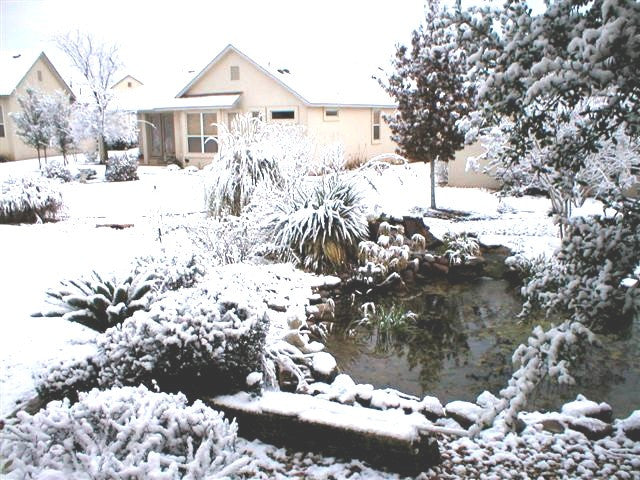After a cool start to the summer months with plenty (too much?) of drought-busting rain, it sure felt hot when the sun finally decided to show itself this August. Still, it’s hard to complain about the heat when it was the rain that kept me nearly out of work for two months. People whose yards are constantly flooded aren’t thinking a lot about adding a water feature to their lives. And to add insult to injury, the rain kept us from being able to go fishing or do much of anything else outdoors. So after about two months of going stir-crazy, I was ready to get back outside and build ponds again, heat and all.


A Texas Pond in Winter Snow on Christmas Eve
As the fall approaches, however, there are a couple of things for owners of a pond that is based on a naturally functioning aquatic ecosystem to think about. When the water is warm and the days are long, the system is functioning at optimum levels. The beneficial bacteria are actively removing ammonia from the fish waste, converting it from a toxic substance to a plant fertilizer, and feeding it to your aquatic plants. The plants are in their growing season converting the available nutrients in the water into vegetable matter. Together the plants and bacteria are competing directly with the algae for the same nutrients and keeping the algae effectively starved out of the system. Most pond owners enjoy feeding their fish during this time of year and the pond’s ecosystem is able to handle those added nutrients as well.
But as the days grow cooler and the nights grow long, natural changes will occur in the pond that may require us to give nature just a little helping hand to keep everything operating smoothly till the next spring. Most aquatic plants go dormant in the coolest part of the year. Water lilies store nutrients in their rhizomes and eventually, except in the warmest parts of the country, stop producing pads and blooms. Other plants such as Iris may stay green all year, but they pretty much stop growing when it’s cold and don’t use nearly as much of the available nutrients as they do during the growing season. In addition to the slowing of the plants’ growth, the beneficial bacteria colonies also slow their consumption of nutrients in cooler water.
Since we lose certain parts of the natural filtration during the cold season the system loses some of its capability to break down organic materials. By removing spent lily pads and blooms we can take some of the load off of the ecosystem. By keeping the skimmer basket emptied when the leaves are dropping, we can remove even more organic material from the water as well as keep the suction to the skimmer stronger. This will insure that more leaves end up in the skimmer where they can easily be removed with less becoming waterlogged and sinking to the pond’s floor. If a plant goes dormant and you want to cut it back, be sure to prune it above the water level so that it doesn’t rot under surface of the water and feed extra nutrients back into the pond.
Adding the beneficial bacteria more often will help spike their numbers and keep the nutrient level down as well. If the bacteria you have are alive but have slowed down their action, then having more in there will help to take up the slack from those who have slowed down. You don’t want to rinse the biological filter mats until the spring clean out, even though you think they must be dirty by now. Dirty they may look, but they’re also full of the bacteria colonies that are still helping keep your water clear and healthy for the fish.
Speaking of the fish, you need to cut back on the amount of food you’re feeding them as the water cools. When their bodies cool down, their metabolism slows and they don’t need as much. In fact, if you start getting algae during this seasonal change, you should stop feeding them altogether. This helps in two ways. Even when the fish eat all the food you throw them, their bodies only use about 10% of the nutrients available. The other 90% leaves the fish and actually becomes algae fertilizer, adding to the problem. By cutting off the supply of algae fertilizer, your algae will eventually stop growing. Plus, with the fish not getting a free handout, they will actually eat the algae that grows on the rocks. Koi and other pond fish are natural bottom feeding scavengers and will readily feed on organic material that’s available to them.
If you live in an area where the water temperature consistently stays below 50 degrees for extended periods of time, you should refrain from feeding the fish at all. Their bodies’ metabolism slows to the point where they can’t process the food. They simply can’t digest it, even though they may want to eat. And it can lead to blockage of the digestive system and can actually cause the death of the fish. If you live in an area where your pond is likely to freeze over during the winter, you don’t need to remove the fish from the pond. Just make sure there is a hole open in the ice so that gases can exchange. You may simply leave your waterfall turned on to provide enough motion and agitation to keep the surface melted in that spot. Otherwise, you can disconnect the pump from the check valve in your skimmer and attach it to a Winter Return Deicer. This allows you to run the pump in the skimmer as normal so that it doesn’t get clogged up. But rather than send the water to the waterfall, it simply returns it directly to the pond. The motion and agitation will keep the water from freezing in that area.
While there be a little added maintenance for us pond owners in the fall, the ecosystem pond is still the lowest maintenance water gardening system you can have. With just a little effort, we can continue to enjoy our pond throughout all four seasons. And whatever happens to the pond in the winter, it will start the next year with a spring clean-out and start the new season as good or better than when it was new. So don’t worry and enjoy and until next month………………………….
…Happy Pondering!
A Texas Pond in Winter

